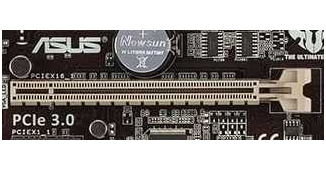What Is PCIe?
A, now common, interface for linking high-speed components is the Peripheral Component interconnect express (as shown below). There are a number of PCIe slots on every desktop PC motherboard which can be used to install SSDs, RAID cards, Wi-Fi cards, and GPUs. The motherboard you have will determine the kind and number of PCIe slots that are available to your computer.

PCle come in five different configurations x1, x4, x8, x16 and x32.The number specifies the lanes (used to transfer data) available to the PCle. A x1 PCle would have a single lane that would be able to transfer data one bit every cycle, while a x4 would have four lanes and could transfer four bits every cycle.
Below is a comparison of the different versions of PCIe over the years
| Version | Bandwidth | GigaTransfer rate | Frequency |
| 1.0 | 8 GB/s | 2.5 GT/s | 2.5 GHz |
| 2.0 | 16 GB/s | 5 GT/s | 5 GHz |
| 3.0 | 32 GB/s | 8 GT/s | 8 GHz |
| 4.0 | 64 GB/s | 16 GT/s | 16 GHz |
| 5.0 | 128 GB/s | 32 GT/s | 32 GHz |
| 6.0 | 256 GB/s | 64 GT/s | 32 GHz |
Version 6.0 is still not out yet however is confirmed to release, the date, however, is still a mystery. The following screenshot was taken from pcisig.com.

What can be plugged into a PCIe slot?
Here are some devices that can be plugged into PCIe slots and a brief explanation of each:
- Graphics Cards: PCIe slots are commonly used for graphics cards, which enable the computer to display high-quality graphics and images. Graphics cards come in various models and offer different levels of performance, from basic 2D graphics to 3D rendering and gaming.
- Network Cards: PCIe network cards are used to connect a computer to a wired or wireless network. They can provide faster network speeds and better reliability than the computer’s built-in network adapter, making them ideal for gaming, video streaming, or other network-intensive applications.
- Solid State Drives (SSDs): PCIe SSDs are a type of storage device that can be used to improve the performance of a computer’s storage system. They offer faster read and write speeds than traditional hard disk drives (HDDs), making them ideal for running operating systems and applications that require fast storage access.
- Sound Cards: PCIe sound cards are used to improve the audio quality of a computer’s audio system. They can offer better audio processing and playback capabilities than the computer’s built-in sound card, making them ideal for music production or gaming.
- USB Expansion Cards: PCIe USB expansion cards can be used to add more USB ports to a computer. They can be useful for connecting multiple USB devices such as external hard drives, printers, and other peripherals.
- RAID Controllers: PCIe RAID controllers are used to manage multiple hard drives in a RAID array. They can provide faster data transfer speeds and better data redundancy than software-based RAID

